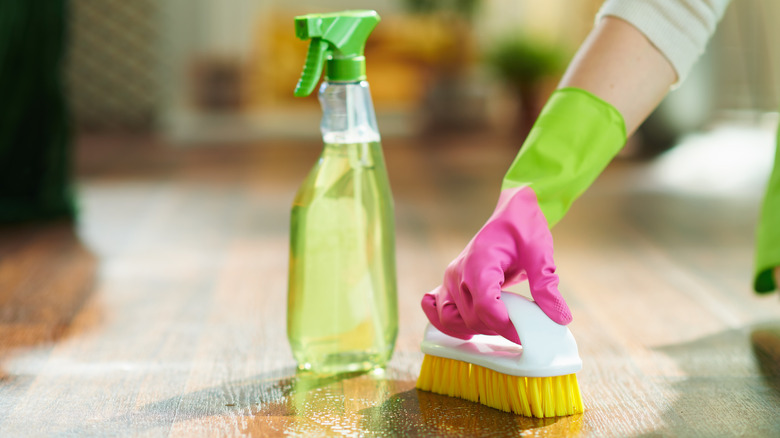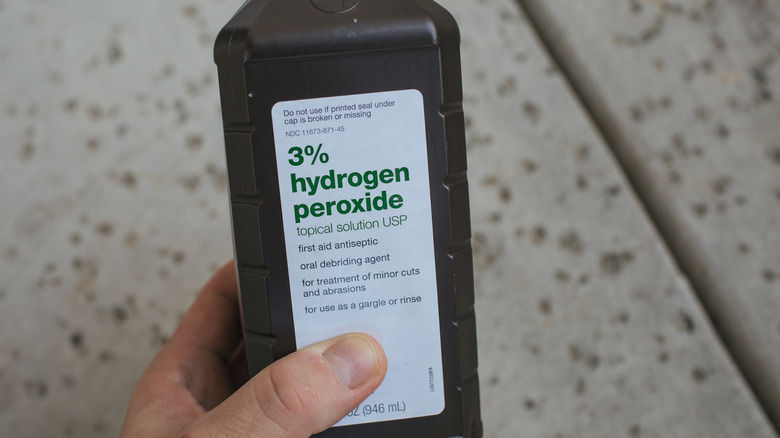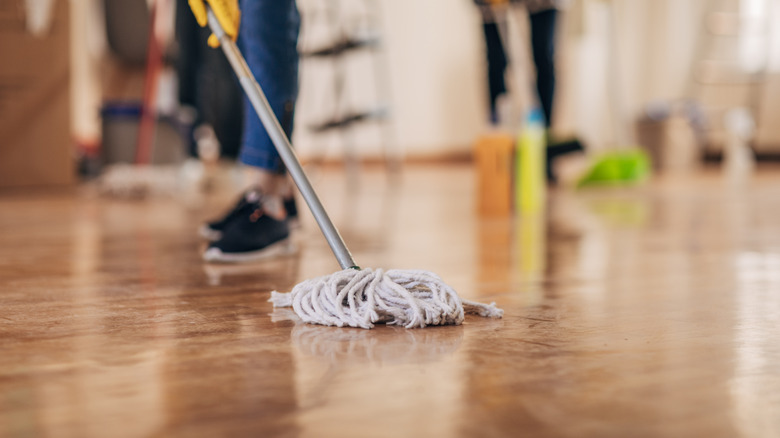Easily Revive Dirty Laminate Floors With A Product You Likely Already Own
Over time, laminate flooring can become discolored, stained, or caked with dirt and debris, especially if they aren't cleaned properly. However, you may already have one of the best laminate cleaning tools in your medicine cabinet. Hydrogen peroxide can not only loosen debris that's ground into the surface of laminate flooring, but it can also help with removing some stains, helping to revitalize your floors without a lot of cost or work.
Laminate floors are typically durable and long-lasting, especially with proper cleaning and removal of dirt and debris from the surface. Yet, it's not uncommon to pull back a carpet or move a piece of furniture to find discoloration and damage to these floors. When that happens, you may feel it's time to replace your laminate flooring, but hydrogen peroxide's oxidating process can remove this material. That's because the oxidation process -– those tiny little bubbles you see when you use hydrogen peroxide on surfaces -– is working to break up the material bonds that typically form between debris and the flooring surface. By doing this and working through the material, it's then possible to simply mop away the dirt.
You can use this method to clean most problems with laminate flooring, including caked-on mud, food stains from jellies and sauces, pet stains, and even blood stains. You'll need to follow a few tips to make it work (and for some serious stains, there are limitations), but it's a fast and easy solution to try.
Why hydrogen peroxide can clean laminate floors so well
You may not have thought to use hydrogen peroxide on the surface of laminate, but its chemical makeup is much like water. The difference is that it has an extra oxygen molecule (it has two hydrogen and two oxygen atoms). When applied to most organic or nonorganic materials, the peroxide releases active oxygen, which is very reactive. It creates damage to the exterior cells of the material, damaging them enough to create a release. This slowly but effectively breaks down the matter, loosening its bond with the laminate itself. Hydrogen peroxide is quite effective at breaking up most types of materials, including creating a bleaching effect on stains, killing germs present, and loosening ground-in dirt. When applied to odors, the hydrogen peroxide interacts with the molecules, neutralizing it and eliminating the scent.
For this reason, when you apply hydrogen peroxide to the surface of laminate flooring, the active oxygen attacks whatever is on the outermost surface, including dirt, germs, and stains. While it does not eliminate that material, it creates enough loosening to allow you to remove it with a wipe. Because it works so well, the hydrogen peroxide may cause some damage to the surface of the laminate. Don't use this method unless you have a build-up of grime on the flooring, and only after you've tested it on a hidden area to ensure no adverse reactions occur.
How to get the best results using hydrogen peroxide
Is the surface of your laminate floors dingy and dirty? In the kitchen, you may have a surface layer of grease on the floor or a build-up of debris on the laminate from dirt. In these situations, there are just a few simple steps to use hydrogen peroxide to get results. Choose between a hydrogen peroxide-based cleaning product or a medical-grade product from your medicine cabinet. To use it to remove stains and dirt, apply a small amount of hydrogen peroxide on a clean towel. Then, apply that to the surface you wish to clean, blotting it to allow the liquid to cover the area. You don't need a lot to create a reaction.
Some laminate flooring can absorb hydrogen peroxide, so pouring a lot of liquid onto the surface isn't ideal as it can increase the risk of damage. However, some stains, especially ones made of food or blood, may require spraying the surface lightly with the peroxide and then wiping it clean. Only allow it to sit on the surface for a few seconds. This should release some of the build-up. You can then mop the floor in the same way you would normally, and more of the residue should come up, creating a like-new surface. Cleaning your laminate floors like this shouldn't be constant, but rather when they need revitalizing.


